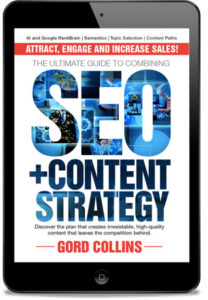Applied Advanced SEO Techniques

There are good number of marketers who believe search engine optimization software might be sufficient to generate market leader ranking results.
In truth, SEO strategy, techniques and tactics come down to sophisticated, knowledgeable human ingenuity. This is even more so today as Google weighs user behavior/engagement and seeks to delete AI-generated content. There are things to avoid as well as to master.
These advanced level techniques described below and practiced by a genuine SEO consultant will make a substantial difference to your traffic and leads from Google.
Advanced techniques ensure you get the most out of your search engine optimization and content marketing budget. And just because a company has a $500,000 marketing budget doesn’t mean they can be sloppy about SEO. Sloppy and non-strategic wastes resources.
David vs Goliath: Strategy and Techniques to Help You Dominate Rankings
I’m very familiar with the challenge of making small businesses compete on Google search. I’ve been doing it for 24 years. This challenge, at times overwhelming, has forced me to build and perfect optimization techniques and tactics governed by a smart strategy out of necessity. Because my competition was usually giant corporations.
I’ve used these strategies to get a stranglehold on all relevant keyword phrases for my clients including brand-related keywords in tough sectors. These techniques are powerful and literally push competitors down and out of the way, or make them disappear by grabbing the most significant presence. Google is looking for the most significant website for its users — its algorithm is its filters and ranking of the most significant pages.
Enjoy these 15 advanced level strategies below and ensure your chosen SEO consultant is a creative, clever master of strategy. Nothing else will do today. Strategy-guiding techniques and tactics make this approach effective.
15 Key Strategies or Techniques Summarized:
- Influencer/Authority voice Backlink Technique
- Keyword Domination Technique
- The College/Association Technique
- Sponsorship Technique
- Skyscraper Technique
- Best Content ever Technique
- Broken Link Discovery Technique
- Guest Blogging Technique
- Wild Promotion Technique
- Social Media Boosting Technique
- Fresh Update Technique
- Clustered Content Technique
- Sequential Topic Theme Domination Strategy:
- Carefully Worded Sentences Technique
- Geographic Domination Technique
Building a Passion for Strategy
An SEO consultant’s love of research, competition, positioning, UVP building, communications, psychology, military style tactics, crafty Pagerank shaping, link bait techniques, and enjoyment of chess or monopoly games makes us ideal for the job. When you have a passion for it, you do want to represent SMBs as best you can. You care about small business survival.
Is high end SEO strategy something an average marketer can pull off? Yes, because even the best elite SEO consultants started humbly. These tips might only be the beginning for you. Genius is often just hard work. In fact, all of this is hard work which is why so few do it.
When the stakes and payoff are high, an Advanced SEO effort can really pay off. By reading up on it now, you’ll develop appreciation and a much better rapport with any SEO expert you may hire. By diving into the topic, you’ll understand their tasks and the inputs, and perhaps do more to help them. In the end, the issue is whether the SEO expert understands the best strategy and can make your company a big winner. Let’s continue the exploration of advanced level SEO Strategy in this post.
Love of Challenge and Competition
Only advanced SEO consultants have the gall, energy, spirit, creativity and stamina to try to compete. For 23 years I’ve done this. I have to tell you though that Google idolizes big companies and wants to squeeze small ones out. It’s a challenge to beat the big money competitors. If you compete too hard, your techniques and tactics can look like spamming to Google. Good strategy, money and software resources, and sufficient time allows you to avoid torturing your efforts and carry this out just the right way.
The point should be made that winning, profitable SEO requires a sufficient sized budget to match the power of who you’re competing with. Without resources, money and time to do things correctly, you may be disappointed. Strategy can only do so much, yet it’s vital when you’re laying out big money. Your SEO consultant can help with an SEO audit and a full digital marketing audit to ensure you have an informed game plan.
What is SEO Strategy?
Most search engine strategies involve the same process of research, designing and building assets to match Google and Bing’s ranking algorithms. The strategy is a long term game plan to tune your site to keyword themes, build engaging content, and enticing relevant website publishers to link to your site. It’s fishing using the right bait. In the end, your strategy is a method of getting your site liked, shared and promoted.
Psychology may play more of a role in high level search engine optimization than any technique. For instance, you may get better results via some content by not using keywords. Sometimes people and machines are annoyed with keyword usage.
Strategic search engine optimization is all about moving people’s minds in a way that helps your website, whatever that way may be.
Please do review the post on Advanced SEO techniques for 2021 and 2022. Advanced SEO includes searcher intent analysis, keyword analysis, establishing SEO KPIs, .
The Advanced SEO Strategy is roughly composed of these 9 steps:
- keyword strategy – research and identify the best keywords to target and use synonyms, long tail phrases, and stemmed variations well
- create your goals and kpis to measure
- visitor intent analysis – what questions are visitors asking, which keywords do they use and what is it they want to do on your site?
- brilliant content strategy – which types of content and topics will attract and engage visitors and create backlinks and whose content is performing best now?
- applied SEO – ensuring ranking signals/cues are available to Google’s spider
- building authority, trust, and expertise with Google
- creating relationships with influencers, bloggers and others who would write about your company and link to it
- publishing on social media to create more exposure and social shares
- analyze performance in rankings, visitor engagement, return visits, and leads generated
As part of your daily search engine optimization tasks, you must monitor Google’s response to your optimization tactics. When rankings fall, you may have lost inbound links, or they have had their power reduced, or Google is signaling it doesn’t like something you’re doing. Could be you’re doing something too much. That’s why a bigger, broader strategy offers “plan b” tactics which avoids Google’s crackdown on SEO.
SEO strategy is a systematic process to build and channel ranking power to power up the best selected keyword phrases. Your results depend on your deliberate well though through approach (technical problem solving and recommendations, improving content, effective keyword choices and strategy, more creative and effective linking, and acquiring links from the best sites).
SEO techniques may only work when you create excellent content. High level SEO often involves an exchange of value of some kind. Dig in and learn more about what content searchers really want.
There’s a significant point to be made that real content quality and how Google interprets it are two different things. Google uses a computer algorithm to rank visible, non-emotional factors which is not the same as your own customers. Google has stated that it doesn’t use user engagement signals which are the defacto evidence of quality.
Further Google values backlinks which is why many companies rank higher than they deserve. They don’t have the best content, but they have a lot of ranking power. That has little to do with content quality. Google is capable of testing for content quality, but they have business and advertising goals themselves and may not really be into quality. Google is more of an advertising platform, and not so much as search engine. Until their monopoly ends, they get to set the rules.
For your site’s optimization, your SEO strategy and content strategy try to synchronize, but will never be 100% fused. Google may find your content valuable for a small portion of your audience but not everyone. These people often find their site missing sometimes from the search results. That’s a signal you need a more advanced optimization.
15 Powerful SEO Strategies to Know
There are more sophisticated SEO technique checklists to use as well, but for brevity let’s stick with the 14 major ones here. An effective strategy will likely utilize all of these.
- Influencer/Authority voice Backlink Strategy: target and connect with journalists, industry people and other companies whose websites have high domain authority.
- Keyword Domination Strategy: This was my favorite strategy. I would optimize for a keyword vertical and every phrase that a core set of keywords were in it. Searchers found my clients every time they searched. That creates omnipresence and generates a hundred times the traffic, rather than putting all your Pagerank chips on one keyword phrase. If you have an unbeatable unique value proposition, then big visibility can really pay off. If your UVP is poor, visitors will come and go.
- The College/Association Strategy: sponsor some college students in relevant educational channels to spread your content/messages out into the college circuit. Create an educational aid they can reference and share. This may result in links from college and university websites, and even government websites and other industry related websites which are highly trusted domains.
- Sponsorship Strategy: targeting industry relevant high domain websites and develop a close relationship, including sponsorships, where you can create content for them. They are influential, have excellent brand value, and that partnership gambit could result in further business opportunities.
- Skyscraper Strategy: identify top content and companies dominating your keyword space and create better content pieces than them (improve on the best content they’ve produced) and message the site owners that link to their content, making them aware that you have something better and more recent.
- Best Content ever Strategy: hire a graphic designer/videographer and pro copywriter to produce epic content which is so engaging, visually amazing, and sharable it doesn’t fail to create links and high quality branding.
- Broken Link Discovery: find additional sites that might link to yours: Find broken links and contact site owners to pitch your better content.
- Guest Blogging Strategy: offer content to relevant websites in your industry with a link or two pointing to your website, and links to other websites whose owners you want to impress.
- Wild Promotion Strategy: promote other companies with mentions, links, and social posts that give them a boost, engage with them and their posts, and they in turn will try to do something in return for you.
- Social Media Strategy: connect with and engage with industry people, influencers, customers and other enthusiasts and make positive comments on their posts and products, thus creating awareness for you. Segment your audience into relevant groups based on their occupation/pursuits then once a month, do paid social boosts to feed relevant content to them.
- Fresh Update Strategy: continuously and frequently update your content with extensive revisions, changes and improvements. Change catches attention and allows to you to re-promote the pages every time you make a change. Google is fighting this by not spidering small publishers frequently, however Bing and Duckduckgo pick up your pages fast.
- Clustered Content Strategy: create interlinked pages focused on related keyword themes, which then link to more central or pillar content pages. This has to be done with more sophistication now since Google can discover and the delimit its power. Content should be relevant but varied because Google punishes redundant/duplicate content, and rewards links from topically relevant content. Search engine spam engineers might call it honeypotting where ranking power is being deliberately poured into central pages. I use a related technique that leverages Google’s preference for one key definitive page on a topic.
- Sequential Topic Theme Domination Strategy: this is where you take it one defined topic at a time. Optimize the site and garner all ranking power and link building to tune to a specific limited number of keyword topics or theme. Build presence and ranking power until you get results, then re-optimize for a new keyword topic. The point is to leverage all of your site’s ranking power at the time to win small battles strategically. Include elements in each of these segments to support your overall long term strategy (core keywords you’re targeting) so it contributes to your long term strategy.
- Carefully Worded Sentences Strategy: yes, Google analyzes sentences for intent and meaning. Each time you link to a particular page in different posts, reword the sentence differently and use unique anchor text to support a wider, richer message. Using the same anchor text, same phraseology, headings etc. is filtered down by Google, and it can create an overoptimization penalty. Consider carefully what the sentence and paragraph is telling Google the target page’s meaning.
- Geographic Domination Strategy: Build significant overall Pagerank/Keyword power via all markets, then refocus it to dominate a specific city or local market, thus overpowering locals who limited their reach to only that market. Engage via social media and provide deep content for the local scene to generate relevance and helpfulness. Customers want services/products that are locally relevant.
Additional Techniques: Of course there are many other advanced tactics and strategic alignment of your content you could employ. Unique and subtle optimizations too can help boost your core keywords, and can help you avoid algorithm shifts that often sink rankings (plan b). The primary tactical goal is to capture Pagerank and lots of links from high domain authority sites (EAT) and then shape or channel that ranking power via anchor link text.
Research then create the correct content topics, lay it out to meet Google and Bing’s expectations, create an engaging story for human visitors, and ensure everything is done corresponds to search engine algorithm’s key ranking criteria. See the post on high ranking strategy. The strategy produces the needed foundational elements such as keyword topics, content structure and strategy, engaging user experience, on page SEO, and link building tactics.
Orchestrate Your Tactics to Stay Attuned to the Ranking Algorithm
The point of high level optimization strategy is to engineer ranking assets in a sophisticated way which compounds and multiplies ranking power. There’s a synergy in how your site resonates which only you may understand. Synergy and deliberate variety works and helps to avoid over-optimization penalties which many sites suffer from.
Google’s indexing system has always been smart. After more than two decades, it’s just more sophisticated. They tried to do it other ways, but couldn’t make them work. It’s the same system but it’s super suspicious of all content and websites. If your content is poor quality, deceptive, not understandable, or pushes too hard, it won’t trust you and will block some of your Pagerank. Then down you go in the rankings.
Most of the material on advanced SEO strategy topics about Google search https://www.google.com/advanced_search is typically off-topic with discussions of keyword tools, and cross-linking, and building content that attracts links. It’s not that you do all these things and much more. It’s how you engineer all of these assets to work together synchronistically. Google attempts to discover the credibility and authoritativeness of what you’re presenting. You present that systematically to help them process it by shaping the pages on your site that have links pointing to them.
A very important tactic is to take the incoming Pagerank/keyword info and then modify it within your page using your target keywords/related and topic semantics. For instance, let’s say someone links to this page and Google believes it is about tactics and strategies. Well, I want to get more out of the inbound link juice because “rankings and strategies” is never searched for and won’t help my ranking strategy. Instead, I want to use anchor text that says, “SEO strategy” and search engine optimization strategy” or “Advanced SEO” in links pointing to other target pages. I’ve not only transferred the pagerank to important ranking pages, I’ve also changed the meaning from something generic to something that can help boost my rankings. Of course the tactic is much more clever than this example shows. It’s not easy to do well.
That conversion of meaning powers up your page’s ability to boost your other pages, for slightly different keywords, the way you need. You take indexing information coming in and you transform it very cleverly to what you need it to be. Google’s robot isn’t a person, and doesn’t know it’s being moved semantically.
Which Advanced Tools to Use?
At an advanced level, the available tools aren’t sophisticated enough to keep up with advanced optimization needs. They can provide insight and find errors however. For link building, they’re very useful. In fact, ahrefs shows in the video below how to discover link building opportunities via outdated content, relevant topics and broken links.
SEO platforms such as Moz, ahrefs, Majestic, and Semrush can help you monitor rankings. ahrefs offers a content explorer module that can help you discover your competitor’s best performing content.
In this video, ahref’s Sam Oh, provides some excellent videos on how to use ahrefs dashboard well.
ahref’s SEO Software Dashboard View

Certainly using the Google Console will aid in understanding and monitoring rankings. Ensure you tag your content based on features within the pages (title tags, anchor text, keyword density, topics, so you can learn more about what Google is favoring or punishing.
The key value in these tools is checking out competitors and scrutinizing backlinks. They can help you understand which pages are rising or falling, and help you identify valuable ranking behaviors. Other software includes social media listening tools and reports on most popular content. These SEO software and social media tools can help you keep up on trending news and topics and also what’s hot out there.
Strategy: Create a Digital Storyline for a Robot Reader
When we say strategy, we’re also talking about creating a storyline, path or journey for Googlebot and ranking system. Google’s system looks for content meaning but also things that fit and validate each other. So strategically, you’ll string these things together in your site’s pages so it’s easy for Google to collect them and process them. You’re laying out a path as you would lay out peanuts for a troublesome pest in your backyard.
Googlebot collects all pages and links, but you still must emphasize which are most important, to use your ranking power best.
At the same time, you’re creating a story with engaging material for your human audience too. That’s why there’s so much editing involved! To get lots of backlinks to rank higher for a long time, you need content people will like and refer to.
It’s a fact that Advanced SEO consultants can’t get the job done without time, resources and money. But before the money arrives, there needs to be some research done and proof that the project will be successful. That means creating a smart plan or strategy to engineer Google’s understanding of your content which leads to high rankings.
Build it Based on How Google Perceives Quality
But first, we need to understand what it is Google values and how to create the quality and relevance signals it needs.
Keep in mind, Google doesn’t divulge specifically how it ranks pages, examines them, or what the frequent algorithm manipulations mean. They want to keep it all hidden, so SEO experts get confused and then can’t manipulate rankings.
The goal is to present content that contains the quality signals needed. The strategy is how the content is packaged and linked for Google to evaluate.
Google’s Key Quality Signals:
These core ranking factors weigh heavier on rankings than about 200 other factors:
- organized and well written content with good citations, facts, images, charts, lists, that include authorities in the topic (perhaps with links to credible content on the web)
- backlinks from top authoritative websites such as colleges, government websites, business associations, and top publications online
- backlinks from content another website that is on topic and uses relevant keywords in a relevant fashion within its copywriting
- relevant and related keywords used in the copy, headings and metatags
- keywords and related phrases in anchor text links
- company with verified identity, location, and business listings (BBB, Google small business, industry directories)
With Google’s ranking algorithm right now, you’ll find big corporations ranking at all top 10 positions. Google has reduced dependence on keywords and value, and is now relying on it’s EAT criteria: Expertise, Authority, and Trust . It is supposed to satisfy Google’s quality rater guidelines .
Your current poor rankings may be due to this. Google plucks out a variety of subtle cues and data that sort of correlates to the EAT criteria. Suffice to say, strategy must pay attention to high quality content and presentation.
Expertise, Credibility and Trust
It’s an important item for an increasing array of topics such as health, legal, and science. Google is looking to control who gets to speak, and corporations are often more moderate and reliable in discussions. They want to filter out the crazies too. We would then prefer to layout topics or blogs and marketing pages in a way that is moderate. The use of superlatives, profanity, and provocative and exaggerated language, including angry, emotional phrases can suggest the author is not credible and level headed and may just be a trouble maker — someone doing evil.
Expressing yourself clearly, validating your claims, and avoiding sensitive topics, words, ideas, etc. can help you avoid getting filtered out by the algorithmic filters and penalties. If your content lacks authoritativeness and trust, it must be captured and fed into the content chain.
In terms of process, it means laying out your written content in a logical orderly fashion. In the process of editing, I will rewrite and rearrange sentences to make them more inviting and entertaining.
The point is to create a compelling content journey. Google can collect it sequentially and satisfy its understanding of a topic so that it believes your content fits the pattern Google set it to recognize. It’s a pattern of quality to the indexing system. If it can validate key points, then you will get passed. If you create a jumble of disconnected ideas and redundant messages, then it won’t believe you have well thought ideas, and that readers will find it unreadable.
Googlebot has the mind of a child, but it is not that creative. In fact, it’s AI system adds incoherence because it tries to understand things it can’t. It’s a flaw and we have to deal with it. The fact is that AI is our assistant, and not the master.
Assess Competitor’s Content and What It Attempts to Achieve
We gain some insight by analyzing the content, websites and backlinks of top competitors. The fact they rank highly means they possess something Google likes. Copying their approach won’t work, but that study may give us info on topics, keywords, composition style, and linking patterns and keyword usage.
Big pictures is, what is their content pointing to overall? Besides their branding and UVP, what frequent benefits, features, keywords, topics, getting at? How do they link their content from page to page within the text sections? What words are in key sentences and near hyperlinks? What do the sentences and headings suggest the content is about?
How do the topics flow from one to the next. How does their content funnel pathway look? Where does it point to mostly? What are their pillar or cornerstone content pieces? Which content is shared the most on social media and which pages are linked to from other websites. You’ll need SemRush or ahrefs SEO software to find that key information.
Consider how you can create content, stories, graphics and benefits that are better than theirs.
The greater part of success however comes from creating very valuable content – the kind of content that draws viewers who will be immersed in it, share it and and link to it from their websites.
Expert Content Research
As part of your Advanced SEO research, you need to understand the product/service, market and the intent of customers. Their need and buying intent is what opens up the content experience and fuels SEO success.
Whatever research methods, sources or tools you use, did into what the relevant, unique value proposition your competitors present and that Google is ranking at the top. Use many varieties of keyword phrases and see which sites consistently appear.
The more variety used, the more Google considers them relevant. Dig into those sites and find out what other websites say about them (backlinks).
In your content, include common material found on other top sites, but also some interesting, unique, and very original content. Think through a logical presentation that leads to some well constructed conclusions. This is good for you human visitors, and works well for Google too.
Differentiate your content, and give it a unique voice and tone that makes it different from the other thousands of competing sites. Set your writing goal for depth and excellence. Longer content tends to perform well as target pages or cornerstone content. Shorter content is easier to consume and helps visitors understand your offer quickly.
Tempt the readers, tantalize them, dazzle and surprise them. Give them a multimedia treat and reward them with giveaways. Keep creating more value and a nice experience. Make people feel intelligent, good and valued and they will share your material. Your research should help you define what that excellent customer experience should be.
Final Notes on Optimization Strategy
The origin of your site’s ranking power comes from other websites. That’s why producing content for others, including guest blog posts, must have your keywords and content topics prebaked in to that content. This is the keyword info that Google applies to your site when linked to your site.
It’s keyword loaded ranking juice that flows via the hyperlinks to your site, which you get to redistribute within your site. That outplaced content also mentions your brand name, top industry brands, .com domain name, and value proposition in your text, not just in the meta description. These often get picked up when other people link to your site. They’re good signals for Google and they look good in the search result descriptions and help increase clickthroughs.
Ranking power and keyword info arrives at your landing pages, and via your internal links is distributed to other pages on your website. Google has reduced the power of internal linking significantly but it is still important. You need to use it well by linking to those pages that are in your strategy.
Link to topically-related pages in a natural way within the main body copy, preferably in the 3rd to 6th paragraphs. Top of page is the hot zone, but first paragraph may be pushing it too much. Let your readers read ad bit before they get a link to click on. In your various blog pages and posts, use different words, phrases and linking. Everything needs to be unique. Bing and Google like unique. Do not rely on your navigation menu links because Google deprecates them.
Contribute to your top industry publications and participate on those websites as it encourages something good will happen.
Find creative ways to present your pages on Facebook, Twitter and Linkedin. Use interesting but not incendiary language. Social media engagement is an art that takes skill. The more joy you have for the topic and the deeper your understanding of the need for it, the more compelling your social posts will be.
Try to boost your posts with paid campaigns to get better reach. Very often, the biggest problem for SEO strategy is a lack of reach. Right now, this means paying for it otherwise you can’t seed your SEO efforts quickly.
High Rankings and big traffic aren’t magic. They’re the result of the talent of a gifted SEO consultant, creative content producer, engaging social media promoter and a good sized budget. The biggest downfall for SEO excellence is the lack of budget. Look at the top performing sites and you’ll see they’ve spent a great deal on research, marketing, branding, advertising, and design. They create an impressive image.
Please do see the SEO audit post, along with the digital marketing performance audit, and the how to rank high on Google article. Underpinning great SEO is a great brand, unique value proposition, and supportive marketing services. Ensure you’re firing on all cylinders and you’ll become the market leader.
Read more info on elite level strategy: SEO Company | Advanced SEO | Advanced SEO Strategy | Real Estate Marketing | Travel Marketing SEO | SEO Services | Digital Marketing Company How to Rank High on Google | Advanced Keyword Strategy | 12 Step SEO Strategy | Best SEO Company | Search Engine Omnipresence | Calgary SEO Services | AI SEO Software | Google Algorithm Updates | Backlink Outreach | Advanced SEO Consultant







